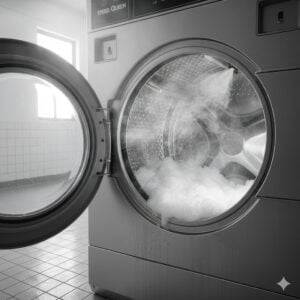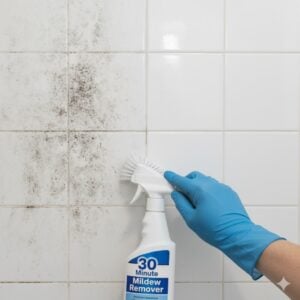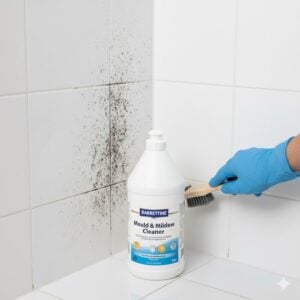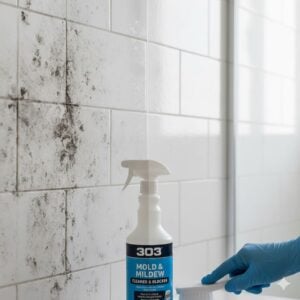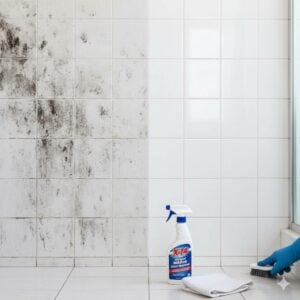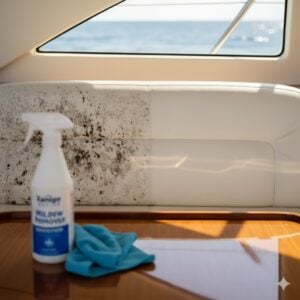Green mold is more than just an eyesore—it’s a sign of deeper moisture and ventilation problems that can affect your health, comfort, and property value. In hot and humid places like the UAE, where air conditioning and insulation trap moisture indoors, green mold can spread fast if not properly addressed. Whether it’s on your walls, furniture, bathroom tiles, or even inside your AC vents, it deserves serious attention.
In this article, we explore everything you need to know about green mold—how it forms, where it thrives, how to clean it, and how to keep it from coming back.
Table of Contents
Toggle1. What Exactly Is Green Mold?
Green mold isn’t a specific type of fungus. It’s a term used to describe mold that appears green in color due to its species or the surface it’s growing on. Most green molds belong to the Aspergillus, Penicillium, or Cladosporium genera. These molds can appear fuzzy, slimy, or dusty and often grow alongside other molds like black or white varieties.
The green appearance is typically caused by spores that reflect green pigmentation, sometimes mixed with yellow, blue, or gray tones. Green mold often grows on damp organic materials such as food, wood, drywall, insulation, or fabric. It may also emit a musty odor and worsen indoor air quality if left untreated.
2. Common Places You Might Find Green Mold in the UAE
Due to UAE’s hot climate and reliance on air conditioning, many homes and apartments become ideal breeding grounds for green mold, especially when combined with poor air circulation or hidden leaks. Here are the most common locations where we find green mold during inspections:
- Ceilings and Corners: Especially near AC vents or in rooms with poor airflow like storage spaces.
- Bathroom Tiles: Grout lines and corners where condensation builds up.
- Window Frames: When windows sweat during temperature changes.
- Behind Furniture: Heavy cabinets or sofas pressed against poorly insulated walls trap humidity.
- AC Ducts and Vents: Mold inside ductwork often shows green around the vents.
- Mattresses or Upholstery: Fabric exposed to humidity with little sun exposure can harbor mold colonies under the surface.
If you see discoloration or smell a persistent musty scent in any of these areas, it’s worth inspecting further or booking a professional mold test.
3. Is Green Mold Dangerous?
Green mold can be harmful, especially for individuals with respiratory issues, allergies, or weakened immune systems. While not all green mold is toxic, certain strains—like Aspergillus fumigatus—can produce mycotoxins or aggravate asthma and other lung conditions.
Health symptoms linked to green mold exposure include:
- Persistent coughing or wheezing
- Nasal congestion or sinus headaches
- Red, itchy, or watery eyes
- Skin rashes or irritation
- Fatigue and general malaise
In severe cases, especially when mold spores are airborne in closed environments, prolonged exposure can lead to fungal infections like aspergillosis. That’s why we always recommend taking visible green mold seriously—even if it seems like a small patch.
4. How to Remove Green Mold Safely
Cleaning green mold isn’t just about wiping it away—it involves removing the source of moisture, disinfecting thoroughly, and preventing regrowth. Here’s a step-by-step approach we usually recommend for small areas:
- Wear protection: Use gloves, a mask, and goggles to avoid contact with spores.
- Ventilate the area: Open windows and use exhaust fans if available.
- Clean the surface: Mix water with mild detergent or white vinegar to scrub non-porous surfaces.
- Disinfect: Apply a mold-killing solution—like hydrogen peroxide or a commercial anti-fungal spray—and let it sit before wiping dry.
- Dry thoroughly: Use a dehumidifier or fan to ensure no moisture is left behind.
Important: If green mold covers more than 1 square meter, keeps coming back, or is found on porous surfaces like drywall, soft furniture, or ceiling tiles, professional remediation is highly recommended. Bio-On offers inspection and removal services priced by area and severity, with optional lab tests if needed.
5. Green Mold vs Black Mold vs Yellow Mold
Many homeowners wonder which type of mold is “the worst.” The truth is: any mold can be harmful in the right conditions. Here’s how green mold stacks up:
| Type | Color | Common Species | Typical Locations | Risk Level |
|---|---|---|---|---|
| Green Mold | Green/Olive | Aspergillus, Penicillium | Walls, food, furniture, vents | Moderate to high |
| Black Mold | Black/Dark Gray | Stachybotrys | Drywall, ceilings, insulation | High – can be toxic |
| Yellow Mold | Yellow/Mustard | Serpula lacrymans | Wood, soil, damp corners | Low to moderate |
The risk is not only in the type but also in the quantity, location, and your home’s airflow and humidity levels. A small patch of green mold under the sink is much less dangerous than a hidden infestation of black mold behind your drywall.
6. Preventing Green Mold in Your Home
Prevention is always cheaper and easier than removal. In our experience helping homeowners across Dubai and Abu Dhabi, these tips go a long way in keeping mold at bay:
- Control humidity: Keep indoor levels below 55% using dehumidifiers or air conditioners with humidity control.
- Fix leaks promptly: Leaky taps, pipes, or AC units should be repaired quickly.
- Improve ventilation: Especially in bathrooms, kitchens, laundry rooms, and storage spaces.
- Use mold-resistant paint: Anti-fungal paints can be a great line of defense on ceilings and walls.
- Inspect hidden areas regularly: Behind sofas, inside wardrobes, or near windows where moisture collects.
We also recommend annual mold inspections for homes that experience condensation, especially if family members suffer from asthma or sinus issues. Catching it early can save you time, money, and health trouble.
Conclusion
Green mold is not something to ignore. While it’s not always toxic, it can lead to serious indoor air issues, health symptoms, and structural damage if left unchecked. In the UAE’s unique climate, it’s especially important to manage humidity, ventilation, and early signs of fungal growth around the house.
If you’ve spotted green mold or suspect it may be hidden behind furniture, walls, or vents, don’t wait. You can contact our team anytime—just click the contact button on the right-middle of this post. We provide fast, professional mold inspections and eco-safe removal solutions across the Emirates.








